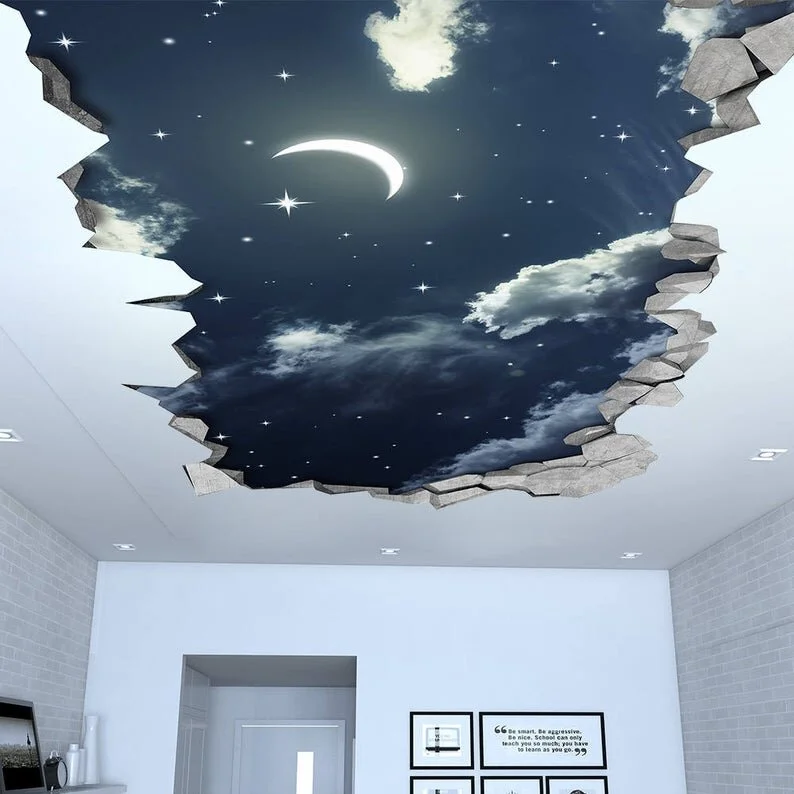Walls don’t need all the color!
Have you ever thought of painting all of your home? Not just the walls, but everything. The whole idea about a home is that it’s meant to reflect you. So why should you limit that to the walls? Who is to say that it has to be one solid color either? There are so many other areas that can be painted, even if it’s just adding small details that add to how your home looks and feels. Floors, ceilings, stairs, what’s stopping you from trying one of them? Here’s a few other places you could add a splash of color to to change the mood.
Make Your Ceiling Stand Out
Surprisingly most people will paint their ceilings white and leave it at that. If they’re really daring, might continue the color of the room across the ceiling and that’s it.
But… why?
It used to be that you would paint your walls white and then paint the ceilings in different colors or designs, or even whole murals. This not only showed your wealth, but it meant that eyes were drawn upwards, and it gave a room a much brighter feel by leaving the walls painted white.
-You could paint patterns of stars, clouds or waves across your ceiling, using stencils or freehand, to bring either interest or peace to a room.
-Consider using either a contrasting or complimentary color to bring attention to it, without making it overbearing.
The Floor is Lava!
Ok perhaps not, but depending on what you have as a floor material in a child’s room, it could be very entertaining to paint their floor as a multitude of games and have an area rug that covers it 90% of the time.
-Alternatively no one said the paint in question had to be permanent. That opens up all sorts of possibilities from encouraging messages to wild patterns that you’re testing out, workouts or game areas. The only limit here is what you’re willing to come up with.
Paint the Walls Red!
Or green, or purple or whatever the Pantone color of the year is. We didn’t say we were only talking about new places right? You’re right. We’ve been painting our walls for eons. What if we told you there’s a way to paint your home whatever color you wanted, even if you’re renting? More interested? There is now paintable, removable wallpaper. Yep, it takes more time than painting straight off, but the exchange is worth it. You can do so much more!
Test one color at a time in a room to find which one you like, without having ugly watches on the wall. Just paint a strip and hang it.
Change your walls every season! Are you the type to go all out, moving furniture and changing out slipcovers with every season? Why not give your walls the same amount of love?
What about for a party? You could easily put up some paper and paint it specifically for the party, or have the attendees write messages all over the wall, depending on what it is.
Paint your apartment that bold red you want, and don’t lose your security deposit over it!
Step It Up
Yup. You knew this one was coming right? Whether you paint the tread or the riser,both are great spots to bring something new.
-You can paint patterns going up the stairs, on the tread.
-Paw prints, encouraging messages, family memories. They’ve all been done.
-You can use the riser to paint a picture that only shows if you’re looking up the stair way. If your walls are full of pictures already, this is a viable space!
-Or you could reference things that matter to you or your family, like favorite books, sports, games, history etc.
This is a seriously underutilized part of the home when it comes to painting! (Check out some of these great examples that we found though!)
You could even get fancy and mix and match ideas, like putting the removable wallpaper on the stair risers so that you can change them out over time.
So, are you looking at things in your home differently? Wondering how you could add color to your world? Let us know either in the comments below or on our Facebook. We want to see where you’re adding color to your life.
Don’t forget that if your appliances are acting up, or you’d like to schedule a maintenance check, you can do that by calling us or creating an appointment. We want to work with you and all of our customers in the Plano area to keep your home running smoothly.








